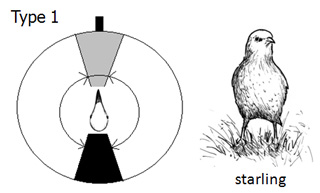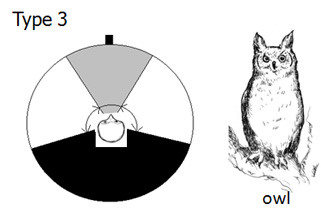|
As seen
in the previous section, eye placement can affect the
size of each of the portions of the visual fields
(binocular field, lateral field, blind area). Scientists
classify avian visual fields in three main types: 1, 2,
and 3.
Visual
field type 1: typical of species like the starling,
which has binocular and blind areas of intermediate
sizes. Given the lateral placement of the eyes, these
species are able to have larger binocular fields than
owls. Species with this type of visual field can see the
tip of their beaks, which allows them to manipulate food
items (imagine a starling trying to eat a squirming
worm).

Visual
field type 2: typical of species like the mallard, which
has small binocular and blind areas, and large lateral
areas due to the largely peripheral placement of the
eyes. In some species, the large size of the blind areas
would allow the animals to see almost around its whole
head (large visual field). These species generally do
not manipulate food items with their beaks (e.g., they
are filter feeders); so they do not require a large
binocular area.

Visual
field type 3: typical of species like the owl, which has
large binocular and blind areas due to the frontal
placement of the eyes. This type of visual field is the
one with the highest similarity to that of humans in
terms of the size of the blind area. These species
generally grab food items with their feet by using their
binocular field while approaching the prey.

Imagine
that these three species (owl, starling, mallard) are
standing head-up in the middle of a city park. What
would be the extent of what they can see around their
heads based on the types of visual fields explained
above?

To answer this question, imagine we take pictures of
what these birds can see at the plane of their beaks as if they
were windows and paste them on a piece of paper. Find
out the answer by downloading this
file.
As you
can see, there are substantial differences in the size
of these windows, being largest in the species with the
most peripherally placed eyes (mallard), and smallest in
the species with the most frontally placed eyes (owl).
For the
small ones, you can download the following coloring
page
showing the main difference between the visual fields of
two species with type 1 and type 3 visual fields.
Previous:
Eye positioning Next:
Foraging and visual fields
|